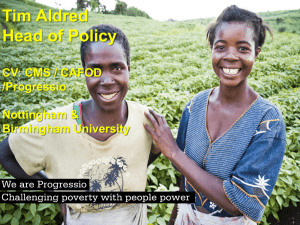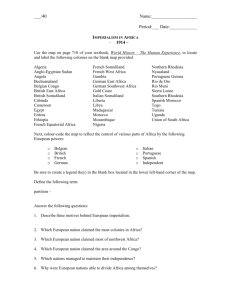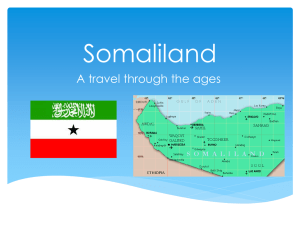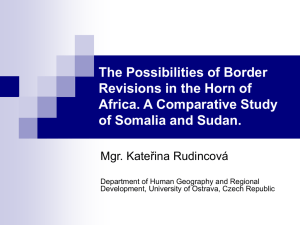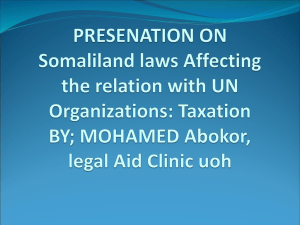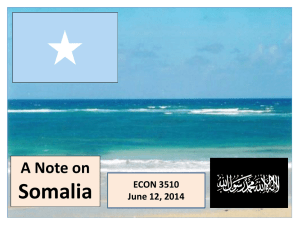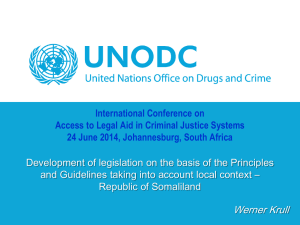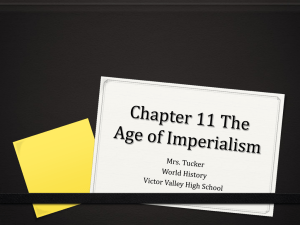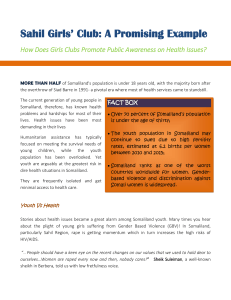When less was more: external assistance
advertisement
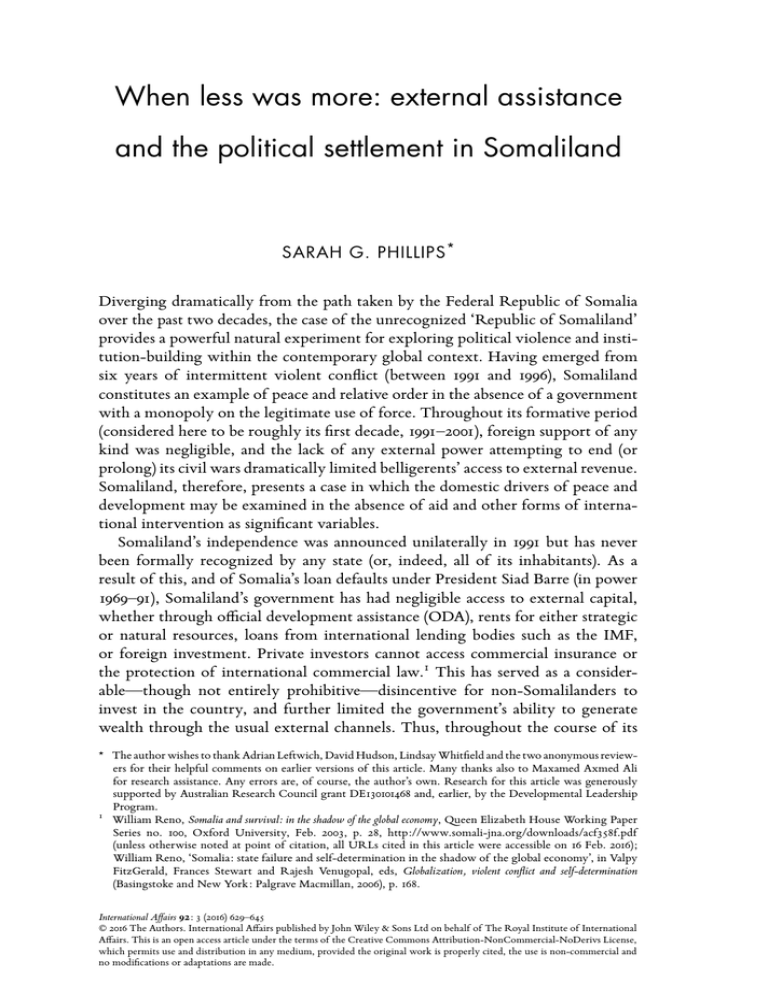
When less was more: external assistance and the political settlement in Somaliland SARAH G. PHILLIPS * Diverging dramatically from the path taken by the Federal Republic of Somalia over the past two decades, the case of the unrecognized ‘Republic of Somaliland’ provides a powerful natural experiment for exploring political violence and institution-building within the contemporary global context. Having emerged from six years of intermittent violent conflict (between 1991 and 1996), Somaliland constitutes an example of peace and relative order in the absence of a government with a monopoly on the legitimate use of force. Throughout its formative period (considered here to be roughly its first decade, 1991–2001), foreign support of any kind was negligible, and the lack of any external power attempting to end (or prolong) its civil wars dramatically limited belligerents’ access to external revenue. Somaliland, therefore, presents a case in which the domestic drivers of peace and development may be examined in the absence of aid and other forms of international intervention as significant variables. Somaliland’s independence was announced unilaterally in 1991 but has never been formally recognized by any state (or, indeed, all of its inhabitants). As a result of this, and of Somalia’s loan defaults under President Siad Barre (in power 1969–91), Somaliland’s government has had negligible access to external capital, whether through official development assistance (ODA), rents for either strategic or natural resources, loans from international lending bodies such as the IMF, or foreign investment. Private investors cannot access commercial insurance or the protection of international commercial law.1 This has served as a considerable—though not entirely prohibitive—disincentive for non-Somalilanders to invest in the country, and further limited the government’s ability to generate wealth through the usual external channels. Thus, throughout the course of its * The author wishes to thank Adrian Leftwich, David Hudson, Lindsay Whitfield and the two anonymous reviewers for their helpful comments on earlier versions of this article. Many thanks also to Maxamed Axmed Ali for research assistance. Any errors are, of course, the author’s own. Research for this article was generously supported by Australian Research Council grant DE130101468 and, earlier, by the Developmental Leadership Program. 1 William Reno, Somalia and survival: in the shadow of the global economy, Queen Elizabeth House Working Paper Series no. 100, Oxford University, Feb. 2003, p. 28, http://www.somali-jna.org/downloads/acf358f.pdf (unless otherwise noted at point of citation, all URLs cited in this article were accessible on 16 Feb. 2016); William Reno, ‘Somalia: state failure and self-determination in the shadow of the global economy’, in Valpy FitzGerald, Frances Stewart and Rajesh Venugopal, eds, Globalization, violent conflict and self-determination (Basingstoke and New York: Palgrave Macmillan, 2006), p. 168. International Affairs 92: 3 (2016) 629–645 © 2016 The Authors. International Affairs published by John Wiley & Sons Ltd on behalf of The Royal Institute of International Affairs. This is an open access article under the terms of the Creative Commons Attribution-NonCommercial-NoDerivs License, which permits use and distribution in any medium, provided the original work is properly cited, the use is non-commercial and no modifications or adaptations are made. Sarah G. Phillips existence the government of Somaliland has been more reliant on its ability to access internal revenue than governments in most other developing countries.2 The purpose of this article is not to establish the salience of Somaliland’s relative isolation in its ability to achieve peace and relative political order, as this is already documented in the literature.3 Rather, it explores the ways in which that isolation fostered mutual dependence between powerful political and economic actors for their survival and prosperity.4 It suggests that a focus on the dynamics of this mutual dependence offers an alternative perspective to that presented in the majority of the statebuilding literature, which instead problematizes the often perverse outcomes of international interventions in conflict-affected states.5 This article also uses the experience of Somaliland to examine three underlying assumptions of western statebuilding and post-conflict transition models. The first assumption is that the more ‘inclusive’ a political settlement—a term discussed below—the greater its popular legitimacy and thus its resilience. For example, the ‘New Deal for Engagement in Fragile States’, which was endorsed by a range of donor and recipient states in 2011, states that its first peace- and statebuilding goal is ‘fostering an inclusive political settlement’.6 The New Deal aims, in part, to transform conceptions of statebuilding from largely ‘top-down’ enterprises of formal institution-building to also embrace ‘bottom-up’ approaches that include a diversity of actors and processes,7 particularly those that have traditionally been marginalized. The second assumption is that effective Weberian governance institutions are a prerequisite of an enduring peace.8 The third is that external assis2 It is important, however, to note the degree to which this has changed over time. For example, the longawaited Somaliland Development Fund came into effect in early 2014. Established through negotiations between the Minister of Planning and the British and Danish governments, it aims to provide money that is administered by an external fund manager, offering a channel through which the Somaliland government can apply for funds. 3 See e.g. Mark Bradbury, Becoming Somaliland (Bloomington: Indiana University Press, 2008); Ioan M. Lewis, Understanding Somalia and Somaliland: culture, history, society (New York: Columbia University Press, 2008); Marleen Renders, Consider Somaliland: state building with traditional elders (Leiden: Brill, 2012). 4 This framework draws on the work of Robert Bates, who argues that when both the political and the economic elite perceive that their ability to survive rests upon their ability to cooperate, political order and prosperity are more likely to prevail. See Robert H. Bates, When things fell apart: state failure in late-century Africa (Cambridge: Cambridge University Press, 2009), p. 17. 5 The literature on the perverse outcomes of international interventions is extensive. Some noteworthy examples include: Astri Suhrke, When more is less: the international project in Afghanistan (New York: Columbia University Press, 2011); Sarah Phillips, Yemen and the politics of permanent crisis, Adelphi Series no. 420 (London: International Institute for Strategic Studies, 2011); Roland Paris and Timothy D. Sisk, eds, The dilemmas of statebuilding: confronting the contradictions of postwar peace operations (London: Routledge, 2009); David Chandler, Empire in denial: the politics of state-building (London: Pluto, 2006); Pierre Englebert and Denis M. Tull, ‘Postconflict reconstruction in Africa: flawed ideas about failed states’, International Security 32: 4, 2008, pp. 106–39. 6 International Dialogue on Peacebuilding and Statebuilding, The ‘New Deal’ on fragile states, 2011, p. 2, http:// www.pbsbdialogue.org/media/filer_public/07/69/07692de0-3557-494e-918e-18df00e9ef73/the_new_deal. pdf. Likewise, a ‘review of the evidence’ by the UK Department for International Development (DFID) notes: ‘The inclusiveness of a settlement, and public perceptions of its fairness, is critical to state legitimacy and the sustainability of the settlement in the long term’: DFID, ‘Building peaceful states and societies: a DFID practice paper’ (London: DFID, 2010), p. 2, https://www.gov.uk/government/uploads/system/ uploads/attachment_data/file/67694/Building-peaceful-states-and-societies.pdf. 7 Alina Rocha Menocal, Inclusive political settlements: evidence, gaps and the challenges of institutional transformation (Birmingham: University of Birmingham, International Development Department, June 2015), p. 6. 8 This literature is extensive. Some prominent examples include: Robert Rotberg, ed., When states fail: causes and consequences (Princeton: Princeton University Press, 2004), p. 36; OECD, Principles for good international engagement in fragile states and situations (Paris, 2007), http://www.oecd.org/dacfragilestates/43463433.pdf; Ashraf 630 International Affairs 92: 3, 2016 Copyright © 2016 The Author(s). International Affairs © 2016 The Royal Institute of International Affairs. External assistance and the political settlement in Somaliland tance is usually necessary to end large-scale violence in developing states or to prevent a recurrence of conflict.9 The ‘political settlement’ framework The term ‘political settlement’ refers to the distribution of power, resources and legitimacy, and the institutions that perpetuate these arrangements, within a political community. It is the suite of measures that channel disputes through mechanisms that render the use of violence unlikely, and that do so with a reasonable degree of predictability. Political settlements are more than simply one-off peace or power-sharing agreements, although these are generally significant moments within the evolution of the arrangements that underpin relative political order.10 A political settlement is an iterative progression in which power, interests and incentives shift or consolidate around ideas about, and perceptions of, what is politically possible. This article adopts a political settlement framework to explore the configurations of power—particularly, who was included in and excluded from political processes, and how those included depended upon one another to maintain their positions as elites—that underpinned the establishment and maintenance of peace in Somaliland. Crucially, it also focuses on the transnational context in which the settlement has evolved—something that is almost invariably absent in the political settlement literature to date. While there are debates in the literature over the precise definition of a political settlement,11 there is an overarching consensus that the place of violence is Ghani and Clare Lockhart, Fixing failed states (New York and Oxford: Oxford University Press, 2008); Paul Collier, ‘The political economy of state failure’, Oxford Review of Economic Policy 25: 2, 2009, pp. 219–40. Paris and Sisk cite the UN Secretary-General’s High-level Panel on Threats, Challenges and Change (2004) as saying that ‘failure to invest adequately in peacebuilding increases the odds that a country will relapse into conflict’: The dilemmas of statebuilding, p. 12. Similarly, the World Bank notes: ‘Countries abandoned by the international development community show few signs of autonomous recovery, and meanwhile their populations suffer severe deprivation’: World Bank, World Bank group work in low-income countries under stress: a task force report, Sept. 2002, p. iv, cited in Jeremy M. Weinstein, Autonomous recovery and international intervention in comparative perspective, working paper no. 57 (Washington DC: Centre for Global Development, 2005). See also DFID, Why we need to work more effectively in fragile states (London, 2005), p. 15, http://www.jica.go.jp/cdstudy/library/ pdf/20071101_11.pdf; Paul Collier, The bottom billion (New York: Oxford University Press, 2007); William Zartman, ‘Putting things back together’, in William Zartman, ed., Collapsed states: the disintegration and restoration of legitimate authority (Boulder, CO: Lynne Rienner, 1995), p. 270; Michael Doyle and Nicholas Sambanis, Making war and building peace: United Nations peace operations (Princeton: Princeton University Press, 2006), p. 4. 10 Edward Laws, Political settlements, elite pacts, and governments of national unity: a conceptual study, background paper no. 10 (Birmingham: University of Birmingham, Developmental Leadership Program, Aug. 2012), http:// publications.dlprog.org/Political%20Settlements,%20Elite%20Pacts,%20and%20Governments%20of%20 National%20Unity.pdf; Adrian Leftwich, ‘Beyond institutions: rethinking the role of leaders, elites and coalitions in the institutional formation of developmental states and strategies’, Forum for Development Studies 37: 1, 2010, pp. 93–111; Mushtaq Khan, ‘Political settlements and the governance of growth-enhancing institutions’, draft paper in research paper series on ‘growth-enhancing governance’, School of Oriental and African Studies, London, 2010, http://eprints.soas.ac.uk/9968/; Thomas Parkes and William Cole, Political settlements: implications for international development policy and practice, occasional paper no. 2 (San Francisco: Asia Foundation, 2010), http://asiafoundation.org/resources/pdfs/PoliticalSettlementsFINAL.pdf; Jonathan Di John and James Putzel, Political settlements: issues paper (Birmingham: University of Birmingham/Governance and Social Development Resource Centre, 2009), http://www.gsdrc.org/docs/open/EIRS7.pdf. 11 Mick Moore, ‘What on earth is a “political settlement”?’, Governance and Development blog (Brighton: Institute of Development Studies, 2012), http://www.governanceanddevelopment.com/2012/09/what-on-earthis-political-settlement.html; Sam Hickey, Thinking about the politics of inclusive development: towards a relational approach, working paper no. 1 (Manchester: Effective States and Inclusive Development Research Centre 9 631 International Affairs 92: 3, 2016 Copyright © 2016 The Author(s). International Affairs © 2016 The Royal Institute of International Affairs. Sarah G. Phillips conceptually central, and that political settlements are fundamentally about how ‘a society solves the problem of violence and achieves a minimum level of political stability and economic performance for it to operate as a society’.12 This article follows Edward Laws’s understanding that ‘a political settlement is only in place where competition for power and resources occurs through institutionalised non-violent political processes’.13 In other words, where violence is chosen over non-violent mechanisms to resolve significant disputes there is no robust political settlement in place to manage power relationships. This does not mean that the state must necessarily claim a monopoly on the legitimate use of force for a political settlement to be in place;14 only that there should be widely respected rules, whether formal or informal, that (almost always) successfully mitigate the use of large-scale violence.15 This article contends that there are three aspects of Somaliland’s political settlement that are of particular importance to the containment and management of violence, and that set it apart from many other places affected by conflict. The first is that the distribution of power and resources evolved under an unusual degree of isolation from international financial or political support,16 and that this fostered a strong degree of mutual dependence among elites. The second is that there were illiberal and exclusionary aspects to that distribution that helped it to cohere initially and, arguably, be maintained subsequently. It is suggested that without the level of international isolation experienced by Somaliland during this period its key actors would have almost certainly been under pressure to adhere—or at least appear to adhere—to international expectations of good governance through strong and vertically inclusive state institutions. Following from this, and finally, the fact that the peace process unfolded without any attempt to arrive at one or more predetermined institutional endpoints meant that the incentives for elites to cooperate were primarily local rather than externally derived. These factors are discussed in turn below. Relative isolation and elite mutual dependence The Republic of Somaliland is not formally recognized by any state, despite fairly broad acceptance that it meets most of the internal criteria for such recognition, with caveats surrounding the government’s monopoly on the legitimate use of violence and the continuing territorial disputes in some border areas. Its achievements are most striking when compared to the level of conflict and underde[ESID], 2013); Björn Dressel and Sinclair Dinnen, Political settlements: old wine in new bottles?, policy brief no. 9 (Australian National University, Development Policy Centre, 2014). 20. 12 Khan, ‘Political settlements’, p. 13 Laws, Political settlements, p. 7. 14 Max Weber, ‘Politics as a vocation’, in Essays in sociology, ed. H. H. Garth and C. Wright Mills (New York: Macmillan, 1946; first publ. 1919), pp. 26–45. The qualification ‘large-scale’ violence is useful to avoid isolated skirmishes being taken as evidence that power relations do not derive from a political settlement. 16 As discussed below, the Somaliland diaspora provided critical funding to the peace process and subsequent development, but its members are not considered as ‘international’ because they are Somalilanders. 15 632 International Affairs 92: 3, 2016 Copyright © 2016 The Author(s). International Affairs © 2016 The Royal Institute of International Affairs. External assistance and the political settlement in Somaliland velopment presided over by successive governments in the Federal Republic of Somalia17—governments that have been almost entirely propped up by external political support and financial assistance. According to a 2012 report by the former head of the Public Finance Management Unit in the Somali Transitional Federal Government (TFG), the Somali government relied on the international community to fund around 70 per cent of its annual budget.18 The World Bank noted that this had been reduced to just over 50 per cent by late 2014 for the Federal Government of Somalia (FGS), which succeeded the TFG.19 Politically, there have also been at least 17 internationally sponsored sets of peace talks aimed at achieving national reconciliation in Somalia to date, most costing millions of dollars and involving large numbers of delegates. These have been under way since June 1991 and have been facilitated at different times by the United Nations, the Inter-Governmental Authority on Development, the Arab League, the African Union, and the governments of Djibouti, Egypt, Ethiopia, Kenya, Turkey, the United Kingdom and Yemen.20 One such conference in Nairobi continued for over two years and was brought to a close only after the Kenyan authorities held a ‘farewell party’ as a way of suggesting that it was time for the Somali delegates to go home.21 In Somaliland, on the other hand, there were several structural and contingent factors that set it apart from the rest of Somalia and that existed even prior to the former’s declaration of independence. Access to outside assistance was already extremely limited throughout the struggle of the Somali National Movement (SNM) against Somali President Siad Barre in northern Somalia between 1982 and 1991, and this appears to have reinforced an ethos of economic and political selfreliance from an early stage in the movement’s development. Northern Somalia’s predominantly pastoral economy made it somewhat more resilient to drought than the south, and as a result the north was not a recipient of international food aid during the famine that engulfed southern Somalia in the late 1980s.22 In fact, foreign aid organizations were evacuated from the north-west of Somalia in May 1988 when Barre’s violent campaign against the SNM and Isaaq (the dominant clan in Somaliland) civilians peaked. This meant that there were virtually no sources of externally provided aid for SNM leaders to loot had they been so inclined.23 Furthermore, in a pastoral economy wealth is largely held in livestock rather than in land, and is thus relatively mobile and more difficult for elites to systematically plunder.24 The south, on the other hand, had a more sedentary agricultural 17 18 The Transitional National Government (TNG, 2000–4) and Transitional Federal Government (TFG, 2004–12). Abdirizak Fartaag, ‘Audit investigative report—2011: Transitional Federal Government’, 20 Feb. 2012, http:// www.somaliareport.com/downloads/Audit_Investigative_Report___2011_Consolidatedx.pdf. 19 ‘In October 2014, budget support from development partners totaled $87 million, compared with $82 million in domestic revenue’: World Bank, Somalia overview, 9 March 2015, http://www.worldbank.org/en/country/ somalia/overview. 20 Interpeace, ‘The search for peace: a history of mediation in Somalia since 1988’, in The search for peace: Somali program (The Center for Research and Dialogue, 2009), pp. 10–23. 21 Mary Harper, Getting Somalia wrong? Faith and war in a shattered state (London and New York: Zed, 2012), p. 64. 22 The north did experience a drought and famine in the mid-1970s, after which a considerable number of Somalilanders left to go abroad. 23 Bradbury, Becoming Somaliland, p. 69. 24 Ernest Gellner, ‘Trust, cohesion, and the social order’, in Diego Gambetta, ed., Trust: making and breaking cooperative relations, electronic edn (Oxford: Department of Sociology, University of Oxford, 2000), p. 144. 633 International Affairs 92: 3, 2016 Copyright © 2016 The Author(s). International Affairs © 2016 The Royal Institute of International Affairs. Sarah G. Phillips production base (and decades of higher levels of investment in that base and in its urban infrastructure), which created substantially more resources for people to fight over. In the south, political competitors fought over access to resources such as food storage points, irrigation pumps, productive farmland, port facilities and urban real estate, not only to enrich themselves but also to maintain the networks of patronage that facilitated their survival.25 In Somaliland, few such assets existed or, where they did, remained after the violence of the late 1980s.26 The peak of the SNM insurgency also coincided with the end of the Cold War, which further reduced the likelihood of its attracting superpower patronage. Instead, the SNM had to rely on the support of its Isaaq clan constituency for solvency, legitimacy and its ability to attract armed men to the struggle. Initially, this support was contingent predominantly on the capacity of the northern Somali diaspora that lived in Saudi Arabia, Europe and East Africa to send money home. The geographical distances between those funding the SNM from abroad and those fighting for it on the ground encouraged the use of a kin-based money transfer system (abban) that kept the funds bound for the insurgency beyond the control of the Barre regime. These remittances went through Isaaq financiers who were based in Ethiopia near the Somali border, from where they sent the money to the SNM. This funding model placed wealthy Isaaq financiers in a political relationship with SNM leaders but did not allow the latter to control the funds, which helped the SNM avoid the southern problem of militia leaders also dominating local businesses.27 To supplement the funding from the diaspora for the war effort, the SNM established various forms of local taxation, including a requirement that every household contribute a payment of at least one sheep (or its cash equivalent) to the movement each year and at least one male to serve in its fighting forces.28 By the late 1980s, most ordinary Isaaq people were contributing both finances and fighters to the SNM, creating a level of dependence on the local communities that made looting them a self-defeating prospect. By the time Somaliland declared its independence, then, it was no stranger to international isolation or to the need to extract revenues locally for political survival. Somaliland’s relative isolation from external support was complemented by the SNM’s relative military success; unlike elsewhere in Somalia, the fighting in Somaliland ended with a military victory by one side.29 This resonates with findings from the literature on civil wars, which highlights the greater likelihood that an outright victory will signal a decisive end to a war than will a negotiated 25 Lee Cassanelli, ‘Explaining the Somali crisis’, in Catherine Besteman and Lee Cassanelli, eds, The struggle for land in southern Somalia: the war behind the war (London: Haan, 2003), p. 15. There were also differences in the degree of fatigue from civil war, with Somaliland having experienced serious violence from the Siad Barre regime since 1982; it is beyond the scope of this article to discuss this difference at greater length. 27 Reno, Somalia and survival, p. 24. 28 Ismail I. Ahmed and Reginald Herbold Green, ‘The heritage of war and state collapse in Somalia and Somaliland: local-level effects, external interventions and reconstruction’, Third World Quarterly 20: 1, 1999, p. 120. 29 Dominik Balthasar, ‘Somaliland’s best kept secret: shrewd politics and war projects as a means of statemaking’, Journal of Eastern African Studies 7: 2, 2013, pp. 218–38. 26 634 International Affairs 92: 3, 2016 Copyright © 2016 The Author(s). International Affairs © 2016 The Royal Institute of International Affairs. External assistance and the political settlement in Somaliland settlement. Roy Licklider shows, for example, that of the 57 civil wars that ended between 1945 and 1993, roughly three-quarters (43) ended in military victory by one side, while the remaining quarter (14) were the result of negotiations between the warring parties.30 Likewise, Monica Duffy Toft argues that wars that end in a ceasefire or a negotiated settlement are more than twice as likely to recommence than wars that end in a military victory.31 The military victory in Somaliland is usually, at least implicitly, credited to the SNM as a unified military force.32 However, by the time that President Barre had been ousted from Mogadishu the SNM had essentially become a symbolic reference point for the various Isaaq clan militias that were fighting in the northwest,33 rather than a coherent martial force in its own right. As an organization, the SNM did not hold a monopoly on the legitimate use of force in 1991; it was the clans that came closest to claiming this, albeit only in their respective local areas. However, despite the SNM’s lack of organizational coherence, there was still no other group in Somalia that seemed to claim an uncontested military victory by the time the central government collapsed. Even if the SNM could only claim this as an umbrella group, it retained a distinct political advantage in the immediate period following the collapse of the Somali central government in 1991. Within two months of Barre’s fall, all northern clans had agreed to accept the political leadership of the SNM.34 Already at this stage, however, the SNM was beset by factional divisions, and its ability to capture the leadership was essentially the result of there being no viable alternative.35 The apparent military dominance of the SNM was short-lived, however, and Somaliland quickly experienced largescale violence again, this time between various Isaaq clan militias. In the south, there was even less martial coherence after the removal of Barre, with many guerrilla factions fighting for power and resources. As the looting in Mogadishu and beyond spread and became more violent, it drew in an everincreasing array of actors and interests. International food and financial aid was increased in an attempt to alleviate suffering, but the aid agencies also became embroiled in the violence by paying belligerents for either protection or access. In so doing they provided ‘undreamt-of opportunities for extortion’,36 and built foundations for further conflict. While the United States and United Nations became more entangled in the conflict, putting together intervention forces and spending a combined total of around $4 billion on peacebuilding processes,37 30 Roy Licklider, ‘The consequences of negotiated settlements in civil wars, 1945–1993’, American Political Science Review 89: 3, 1995, p. 684. Monica Duffy Toft, Securing the peace: the durable settlement of civil wars (Princeton: Princeton University Press, 2009), p. 8. See also Barbara F. Walter, ‘The critical barrier to civil war settlement’, International Organization 51: 3, Summer 1997, pp. 335–64. 32 See e.g. John Drysdale, Somaliland: the anatomy of secession (Hove: Global-Stats, 1992), pp. 24–7. 33 Renders, Consider Somaliland, p. 80. 34 Drysdale, Somaliland, pp. 13, 24. 35 Mohamed Ibrahim and Ulf Terlinden, ‘Making peace, rebuilding institutions: Somaliland—a success story?’, in Axel Harneit-Sievers and Dirk Spilker, eds, Somalia: current conflicts and new chances for state building (Berlin: Heinrich Böll Foundation, 2012), p. 54. 36 Daniel Compagnon, ‘The Somali opposition fronts: some comments and questions’, Horn of Africa 13:1, 1990/1, p. 86. 37 Gerard Prunier, ‘Somaliland goes it alone’, Current History 97: 619, p. 227. 31 635 International Affairs 92: 3, 2016 Copyright © 2016 The Author(s). International Affairs © 2016 The Royal Institute of International Affairs. Sarah G. Phillips they contributed nothing to such processes in Somaliland. With the exception of around $100,000 provided by two western donors (one Swedish, one American) for the Borama Conference in 1993, there was virtually no external funding behind the peace conferences between 1991 and 1997, other than from members of the diaspora. Exclusion and the political settlement After the first major clan conference following Somaliland’s declaration of independence, in Borao in April and May 1991, security in the north-west remained extremely precarious. Some groups had spontaneously demobilized but many had not, and armed young men with combat experience returned to devastated communities where some sought to earn a living through coercion.38 Some militia groups established checkpoints along trade routes to extort money and goods from passers-by; others took control of key public infrastructure, particularly ports and airports, within their clan territory as a means of extracting revenue. By 1993, the government estimated that there were some 50,000 armed clan militia members across Somaliland.39 The cohesion among the Isaaq clans that had helped the SNM defeat Barre’s forces had dissipated, and Somaliland’s first president, Abdirahman Ali Tuur, was proving incapable of reining in the militias that were competing for control over public resources. The fight over resources became increasingly focused on clan divisions as elites on all sides of the power struggle mobilized support from within their clans—in turn helping to spread the conflict to other areas inhabited by these same clans. In 1992, the worst of this fighting surrounded control of Berbera port, and the right to tax the ‘public’ revenue that flowed through it. One of the most important insights from the political settlements work to date is the uncomfortable finding that vertically exclusive distributions of power and resources—that exclude most non-elites—may be more likely to augur political stability, at least in the short to medium term, than those that are vertically inclusive.40 This appears to have been the case in Somaliland, much of whose relative stability can be attributed to the collusive commercial and clan-based arrangements that were established to end the fighting around Berbera between 1991 and 1993. When Mohamed Ibrahim Egal ousted Abdirahman Ali Tuur as president in a vote held at the Borama peace conference in 1993, President Egal moved quickly to draw in the major traders, whose businesses relied on secure access to the facilities at Berbera port, as creditors to fund the demobilization of militias, establish the basis of an army, and gain control over key economic infrastructure, in particular consolidating control over Berbera port. Egal secured loans of around $6 million 38 Cabdirahman Jimcaale, ‘Consolidation and decentralisation of government institutions’, in Rebuilding Somaliland: issues and possibilities (Lawrenceville, NJ: Red Sea Press, 2005), p. 61. ‘Consolidation and decentralization of government institutions’. See Hickey, Thinking about the politics of inclusive development; Laws, Political settlements; Stefan Lindemann, ‘Inclusive elite bargains and the dilemma of unproductive peace: a Zambian case study’, Third World Quarterly 32: 10, 2011, pp. 1843–69. 39 Jimcaale, 40 636 International Affairs 92: 3, 2016 Copyright © 2016 The Author(s). International Affairs © 2016 The Royal Institute of International Affairs. External assistance and the political settlement in Somaliland from a small group of eight Isaaq traders, six of whom were from his own Habar Awal clan (a sub-clan within the Isaaq).41 By offering these traders extremely generous tax exemptions on the goods they transported through Berbera port, Egal provided the Isaaq commercial elite with opportunities to monopolize business in the north without the risk of needing to re-enter Mogadishu. These vertically exclusive arrangements helped to lay the foundation for the monopolistic practices that still pervade Somaliland’s domestic economy.42 By 1995 Egal had established an army of around 5,000, largely from the militias that had been disarmed.43 However, it was estimated that there remained some 10,000 militia members to be demobilized, and the resurgence of conflict in 1994 facilitated a wider remobilization along clan lines,44 leading to Somaliland’s next civil war (1994–6). In 1994, Egal delivered another windfall to his Habar Awal financial backers by using their money to fund the creation of a new national currency. This time, Egal borrowed $1.4 million to have the new Somaliland shilling printed in London, and introduced it as the new currency in September 1994.45 In an act that was laden with the symbolism of Somaliland’s declared independence, and also filled Egal’s immediate fiscal needs, the old Somali shilling was declared to be no longer legal tender within Somaliland by January 1995. However, instead of destroying the recalled Somali shillings, Egal sold them to his lenders at a heavily reduced rate in return for hard currency, which he used to fund his fight against the militias that in 1995 were trying to gain control over Hargeisa airport. The traders were able simply to transfer the old (and now cheap) Somali shillings to the parts of Somalia that still used it as the national currency;46 Egal gained hard currency and the traders made a substantial profit. By means of the combination of exclusive business practices and somewhat greater control over the means of coercion, Egal and his coalition of supporters edged out their political and economic competitors to dominate the economy, putting Egal in a position to increasingly centralize patronage and dislodge the clan elders from their position of political dominance. Egal netted huge amounts of money for selected cronies and thereby simultaneously indebted them to him. In the process he harnessed popular sentiment regarding the viability and righteousness of Somaliland’s independence and its quest for sovereign recognition. Large-scale business was made into an exclusive club, membership of which 41 The figure of eight traders comes from the Director of Planning and Statistics at Somaliland’s Ministry of Finance, who was in that position when the loan took place and who listed each lender (interview, Hargeisa, 13 June 2013). There are some discrepancies in the literature, however. For discussion see Sarah Phillips, Political settlements and state formation: the case of Somaliland, research paper no. 23 (Birmingham: University of Birmingham, Developmental Leadership Program, Dec. 2013), p. 47. 42 Luca Ciabarri, ‘Trade, lineages, inequalities: twists in the northern Somali path to modernity’, in Markus Hoehne and Virginia Luling, eds, Peace and milk, drought and war: Somali culture, society and politics (London: Hurst, 2010), p. 80. 43 Jimcaale, ‘Consolidation and decentralisation’, p. 22. 44 Balthasar, ‘Somaliland’s best kept secret’, p. 225. 45 Egal had more shillings printed in 1996 and 1999, in both cases funded by loans from business elites (interview with Director of Planning and Statistics at Somaliland’s Ministry of Finance, Hargeisa, 13 June 2013). See also Bradbury, ‘Becoming Somaliland’, pp. 111–2. 46 Renders, Consider Somaliland, pp. 134–5. 637 International Affairs 92: 3, 2016 Copyright © 2016 The Author(s). International Affairs © 2016 The Royal Institute of International Affairs. Sarah G. Phillips was available in exchange for economic support of Egal’s statebuilding project. For both Egal and the merchants there was a perception that continued success in politics and business was contingent on—or at least enhanced by—a willingness and capacity to cooperate with one another. Through their cooperation they consolidated an economic settlement that excluded many but laid the groundwork for relative peace. Exclusive though that settlement was, Egal’s ability to extract these loans—and lavishly reimburse his creditors with ‘public’ money—was (and remains) widely accepted by most Somalilanders as having been a legitimate goal. One of the most widely lauded aspects of Somaliland’s peace process in the English-language literature is its inclusivity, which is framed as having been vital to its success.47 The literature also highlights the egalitarian and consultative aspects of clan-based institutions as core pillars of that success.48 However, while the peace conferences were highly inclusive of grassroots communities, the funding model that lay behind demobilization, and underwrote President Egal’s statebuilding project, was not. Thus, while Somaliland’s peace process is conventionally seen through a lens of inclusivity, economic exclusivity was integral to the shape the process took and also, arguably, to its success. The maintenance of peace was, and remains, the gravitational centre of Somaliland’s political settlement; it is the issue around which all other political and economic considerations orbit. On this basis, peace is exchanged for relatively restricted access to the key drivers of economic growth, which has prompted some observers to describe Somalilanders as ‘hostages to peace’.49 Thus far, the exchange has been broadly acceptable within the parts of Somaliland that support independence—that is, excluding the (non-Isaaq) inhabitants of much of the east and parts of the far west. The eastern areas of Sool, Sanaag and southern Togdheer are simultaneously claimed by Puntland, a region that has declared autonomy (though not independence) from the Federal Republic of Somalia. Many within these areas oppose Somaliland’s claim of independence, and sporadic armed conflict against the government of Somaliland continues.50 Their rejection of independence is coupled with the claim 47 Peter Pham, ‘The Somaliland exception’, Marine Corps University Journal 3: 1, Spring 2012, p. 31; Mark Bradbury, Adan Yusuf Abokor and Haroon Ahmed Yusuf, ‘Somaliland: choosing politics over violence’, Review of African Political Economy 30: 97, 2003, p. 473; Edward Paice and Hannah Gibson, eds, After Borama: consensus, representation and parliament in Somaliland, Policy Voice series (London: Africa Research Institute, May 2013); Interpeace, ‘A synthesis report of the peace mapping study’, in The search for peace: Somali program (The Center for Research and Dialogue, 2009), p. 55; Steve Kibble and Michael Walls, ‘Beyond polarity: negotiating a hybrid state in Somaliland’, Africa Spectrum 45: 1, 2010, p. 46. 48 Volker Boege, Anne Brown, Kevin Clements and Anna Nolan, ‘Building peace and political community in hybrid political orders’, International Peacekeeping 16: 5, 2009, pp. 609–11; Mohammed Hassan Ibrahim and Ulf Terlinden, ‘Somaliland: “home grown” peacemaking and political reconstruction’, in Mark Bradbury and Sally Healy, eds, Whose peace is it anyway? Connecting Somali and international peacemaking, Accord: An International Review of Peace Initiatives, issue 21, 2010, pp. 76–9; Ibrahim Hashi Jama, ‘Making the Somaliland constitution and its role in democratization and peace’, in Bradbury and Healy, eds, Whose peace is it anyway?, pp. 89–90. 49 Matt Bryden, ‘The “banana test”: is Somaliland ready for recognition?’, Annales d’Ethiopie, vol. 19, 2003, p. 363; Human Rights Watch, Hostages to peace: threats to human rights and democracy in Somaliland (New York, 2009), http://www.hrw.org/sites/default/files/reports/somaliland0709web.pdf; Nicole Stremlau, ‘Hostages of peace: the politics of radio liberalization in Somaliland’, Journal of Eastern African Studies 7: 2, 2013, p. 239–57. 50 While Somaliland’s territorial claims are made on the basis of Anglo-Italian colonial borders, Puntland’s rest on a ‘genealogical logic’ that includes territories inhabited by the Dhulbuhante and Warsengeli clans. See Markus Virgil Hoehne, Between Somaliland and Puntland: marginalization, militarization and conflicting political visions (London: Rift Valley Institute, 2015), p. 21, riftvalley.net/download/file/fid/3719. 638 International Affairs 92: 3, 2016 Copyright © 2016 The Author(s). International Affairs © 2016 The Royal Institute of International Affairs. External assistance and the political settlement in Somaliland that non-Isaaq areas are marginalized by the political cliques of Hargeisa. This points to another aspect of exclusion within Somaliland’s political settlement: inclusion rests on the ideological acceptance of Somaliland’s claim of independence from Somalia. The term ‘Somaliland’ is, therefore, not a neutral one, and is used almost exclusively by those who support its call for sovereign recognition. While this collusive model of development chimes with historical narratives of state formation in Europe by sociologists such as Charles Tilly and Norbert Elias,51 it is out of step with contemporary international expectations that peace and development emerge through inclusive, liberal processes that are conducted through the channel of formal state institutions. No predetermined institutional endpoints Unlike many conflict-affected places targeted by international statebuilding initiatives, the political settlement that limited large-scale violence in Somaliland evolved without explicit externally driven expectations, schedules or technical indicators of success.52 As Farah and Lewis explain of the most important peace conference (at Borama in 1993): The Boorama [Borama] conference was set to start in January but was delayed until February. To discredit the government, which was against it, the elders declared it open on February 24th with virtually no preparation. It was opened with seven days devoted to reciting the Koran so as to give time to effect arrangements. The actual business started on March 3rd.53 External actors considered Somaliland’s peace process as peripheral to events in and around Mogadishu, which gave Somalilanders wide latitude to negotiate their own locally legitimate institutional arrangements. The inter-clan conferences that took place in Somaliland between 1991 and 1997 were the most important forums in which north-western elites negotiated the ‘rules of the game’ that sustain Somaliland’s political settlement.54 It was here that the frameworks for national security, political representation and the constitution were largely established. The rules consolidated during this time established that the building and maintenance of peace should be politically inclusive, use widely understood (though not strictly ‘traditional’) mediation techniques, maintain a relative balance of power between clans and sub-clans, and not rely on outsiders to solve Somaliland’s problems. Though this was not made explicit at the time, there was a distinct lack of reference to specific milestones, including timetables for elections or constitutional 51 Charles Tilly, ‘Reflections on the history of European state-making’, in Charles Tilly, ed., The formation of national states in western Europe (Princeton: Princeton University Press, 1975), pp. 3–83; Charles Tilly, ‘War making and state making as organised crime’, in P. Evans, D. Rueschemeyer and T. Skocpol, eds, Bringing the state back in (Cambridge: Cambridge University Press, 1985), pp. 169–91; Norbert Elias, The civilizing process: the history of manners and state formation and civilization (Oxford: Blackwell, 1994), p. 351. 52 Bradbury, Becoming Somaliland, pp. 246–7. 53 A. Y. Farah and I. M. Lewis, ‘Making peace in Somaliland’, Cahiers d’études africaines 37: 146, 1997, p. 373. 54 There were a total of 32 major reconciliation conferences during that period, the most important of which were held at Borao (1991), Sheekh (1992), Borama (1993) and Hargeisa (1996–7): Jimcaale, ‘Consolidation and decentralisation of government institutions’, p. 64. 639 International Affairs 92: 3, 2016 Copyright © 2016 The Author(s). International Affairs © 2016 The Royal Institute of International Affairs. Sarah G. Phillips drafts, to measure progress along the way. Instead, the actors at the conferences drew on existing rules and norms, such as the concept of informality, consensus over majority voting, customary law and mediation practices (xeer), proportional representation for the clans (beel), and the maintenance by each clan of considerable autonomy within, and responsibility for, events occurring within its territory. Local communities were overwhelmingly responsible for funding the clan peace conference, which constituted a considerable financial burden for the hosts. For the 1993 Borama conference, for example, the hosts from the Gadabursi clan were obliged to provide food and shelter for some 2,000 participants over a five-month period. The participants were quite aware of the imposition being placed on their hosts, and of the reciprocation that was likely to be expected of them. The local funding of the conference helped to remind participants that time must not be wasted. Decisions at the Borama conference were almost always taken on the basis of consensus being reached between parties rather than as the result of a majority vote. This was time-consuming, but it was felt by participants that consensus was more likely to achieve a legitimate and durable result. When seemingly intractable issues arose, parties were given deadlines (sometimes repeatedly), in order that the end result would be an agreement that was acceptable to all, rather than the issue being put to a vote. One of the elders present reportedly explained that the general view at the conference was that ‘voting is fighting; let’s opt for consensus’.55 Interpeace notes that at times the chairman would ‘fall ill’ when an important agreement remained out of reach in order to allow further time for discussion—and, presumably, a face-saving outcome for those involved.56 Somalilanders were not, therefore, under pressure to adhere to specific institutional endpoints, such as those associated with liberal democracy, good governance or international ‘best practices’. Instead, they had the freedom to cherry-pick from local and international institutional models, and to experiment with what was likely to work in the local context. Participants’ incentives to find solutions were overwhelmingly internal, and thus immediate, rather than responses to external pressure, as was often the case elsewhere in Somalia. The peace that was built in Somaliland offers a counterpoint to models offered in the mainstream statebuilding and development literature—and widely followed by development practitioners—in which peace and political order are seen as primarily the result of neo-Weberian institutional incentives and constraints. Here, the lack of rational–legal institutions may have made politics less predictable, but also appears to have created a logic of action upon which order has rested. In fact, the very weakness of Somaliland’s formal institutions appears to have provided an incentive for peaceful cohabitation between those with the capacity to organize violence—a finding that runs contrary to the structural accounts of order that dominate the literature. 55 Cited in Interpeace, ‘Peace in Somaliland: an indigenous approach to statebuilding’, in The search for peace: Somali program, p. 52. 56 Interpeace, ‘Peace in Somaliland’, p. 52. 640 International Affairs 92: 3, 2016 Copyright © 2016 The Author(s). International Affairs © 2016 The Royal Institute of International Affairs. External assistance and the political settlement in Somaliland Education and elite mutual dependence Local context drove not only the formation of Somaliland’s organizations and institutions, but also the selection of those administering them. Political elites were able to draw from a pool of relatively well-educated Somalilanders to staff the nascent bureaucracy, rather than needing (or being expected) to rely on outsourced international ‘technical assistance’ or ‘technical expertise’, as is usually the case in donor-funded statebuilding programmes. During field research for this project, one response stood out when participants were asked why Somalilanders had been able to successfully negotiate and maintain peace and relative order: Sheekh Secondary School. Amoud Secondary School was also often mentioned. For example: The leaders of the SNM were well educated and it was they who were so influential in the conferences ... [their secondary education was at] Sheekh and Amoud schools—almost all of them. These were the only two schools that offered GSCs [the General Certificate of Education] in the country.57 One indication of the extent to which these two schools feature in the backgrounds of Somaliland’s most influential leaders is that three of Somali­ land’s four presidents to date attended Sheekh School;58 the fourth, Dahir Rayale Kahin, went to Amoud. All three vice-presidents also went to Sheekh School, and one (Abdirahman Aw Ali) attended Amoud as well.59 As part of the research for this project, a member of the research team compiled a list of the political and technocratic actors (ministers, senior bureaucrats, politicians, members of civil society, etc.) who would be widely accepted within Somaliland as having had the most political influence in the country since 1991 (clan elders were listed elsewhere). While an individual’s inclusion in the resulting list of 57 people was a partially subjective judgement, it was one that was made before a person’s educational background was known by the team. Of all for whom educational details could be found (50 out of 57), half (25) had attended Sheekh School. Six had attended Amoud School (in Borama), and eight Lafoole College near Mogadishu. Only one person on the list appeared to have had no formal education. A similar, though also necessarily subjective, list of politically influential poets revealed that four out of five of them had attended Sheekh School, while just one had had no formal education. It is widely accepted that the early SNM leadership comprised ‘mostly people from Amoud or Sheekh secondary schools’.60 At least six of the 20 imprisoned members of Uffo (a self-help group that spearheaded early resistance to the Barre regime in the early 1980s) had also been to Sheekh School, as had a high proportion of President Egal’s first cabinet. As one graduate of the school noted: 57 Interview 58 with the deputy chairman of a prominent civil society organization, Hargeisa, 27 March 2013. Technically, Sheekh School was an intermediate school prior to becoming a full secondary school under Richard Darlington in the mid-1950s. 59 President Dahir Rayale Kahin also served as vice-president from 1993 until the death of President Egal in 2002, when he became president. 60 Interview with early SNM member, Hargeisa, 1 Dec. 2012. 641 International Affairs 92: 3, 2016 Copyright © 2016 The Author(s). International Affairs © 2016 The Royal Institute of International Affairs. Sarah G. Phillips In Egal’s cabinet there was a high number of Sheekh graduates ... At least seven of the key cabinet members in Egal’s first cabinet members were from Sheekh, maybe more, but it was around a third of them—it’s always this way, always around a third.61 These figures are even more extraordinary when one considers the small number of students who attended Sheekh School. The school accepted only 50 students each year for the 31 years (1958–89) before it was destroyed in the war: just 1,550 people over three decades.62 One graduate noted: ‘There were only 50 graduates a year, and at least 50 per cent of these went abroad.’63 Sheekh School was a privately funded, merit-based, secondary boarding school that offered free tuition based on a British curriculum to the top male students in Somaliland. It had a strong emphasis on extra-curricular activities, including debating, dramatic productions and competitive sports; was organized on a ‘house’ system; and provided for students to elect individuals from among their number to lead some of the school’s administrative functions. While Sheekh was a selective school that offered entry on the basis of students’ exam marks, the headmaster, Richard Darlington (mid-1950s–1971), was adamant that the student body should be inclusive of all clans (albeit only their male members). According to one graduate, preferential entry was offered to some students from the marginalized (and non-Isaaq) eastern regions of Sool and Sanaag, but ‘for everyone else it was on grades’.64 In addition to the training in leadership and critical thought that Sheekh students received, alumni pointed to the importance of their educational experiences in building and consolidating networks of trust among the student cohort that were, in some cases, maintained decades later. One graduate even referred to the networks that have emerged from the school as functioning ‘like a secondary tribe’ because of the level of trust that was built by the shared experience of being a student at Sheekh.65 There are a number of other cases across Africa of similar educational networks becoming established, and of one or more particular secondary schools having been particularly salient in the educational backgrounds of a country’s national leaders. For example, in Mauritius, Deborah Brautigam and Tania Diolle found that an ‘unusually high number of people who were stakeholders and decision-makers at independence were graduates of the island’s elite, meritocratic government-run secondary school, Royal College’.66 David Sebudubudu writes that in Botswana, ‘many of the elite studied together in institutions outside the country and/or in a few elite schools within the country, [where] they developed a common political and social value system’.67 A similar pattern is also apparent in Ghana, where the 61 Interview with Sheekh School graduate 62 Sheekh School was reopened in 2003. 63 Interview with Sheekh School graduate 64 Interview with Sheekh School graduate 65 Interview with Sheekh School graduate 66 ‘a’, class of 1974, Hargeisa, 2 Dec. 2012. ‘b’, class of 1974, Hargeisa, 4 Dec. 2012. ‘a’, class of 1974, Hargeisa, 2 Dec. 2012. ‘b’, class of 1974, Hargeisa, 4 Dec. 2012. Deborah Brautigam and Tania Diolle, Coalitions, capitalists and credibility: overcoming the crisis of confidence at independence in Mauritius, research paper no. 4 (Birmingham: University of Birmingham, Developmental Leadership Program, April 2009), p. 32, http://publications.dlprog.org/Coalitions,%20Capitalists%20and%20 Credibility.pdf. 67 David Sebudubudu, Leaders, elites and coalitions in the development of Botswana, research paper no. 2 (Birmingham: University of Birmingham, Developmental Leadership Program, April 2009), p. 29, http://publications. dlprog.org/Leaders,%20Elites%20and%20Coalitions%20in%20the%20Development%20of%20Botswana.pdf. 642 International Affairs 92: 3, 2016 Copyright © 2016 The Author(s). International Affairs © 2016 The Royal Institute of International Affairs. External assistance and the political settlement in Somaliland backgrounds of key reformist leaders reveal the importance of networks built during education at elite, though meritocratic, secondary schools, particularly Achimota, where around one-quarter of the country’s most significant developmental elite studied.68 Of course, uneducated people can be effective leaders, just as well-educated leaders can be ineffective, or criminal, or preside over political and economic ruin. The literature on peacebuilding does not find strong positive correlations between education levels and peacebuilding or political order.69 However, the focus of this literature tends to overlook the role of education in contributing to the ‘emergence of developmental leadership’.70 Of itself, good-quality secondary education is not a sufficient condition for the emergence of a durable political settlement, but the experience of Somaliland suggests that it may at least be conducive to the development of such a settlement. The role of the Sheekh School graduates in the early bureaucracy also points to the degree of mutual dependence that existed between Somaliland’s stakeholders in the post-conflict transition. Not only did political elites have little choice other than to rely on local capacity when Barre’s removal created space for an alternative political order, but there was a sufficiently skilled cadre available to answer the call. Conclusions For Somaliland, less external involvement meant a greater need for local elites to depend on one another to retain their positions of power, and greater political space for locally legitimate solutions to emerge. Because there were no external groups working either to end or to perpetuate the conflicts in Somaliland, not only did belligerents have almost no access to international revenue streams, they had no external political cover either. Instead, local communities (including women’s networks), the local business elite and the diaspora provided the logistical and financial resources necessary to bring the conflicting parties together for peace negotiations. The fact that the funds for the conferences were locally sourced meant that participants were acutely aware of the need to use them judiciously. Being seen to waste resources carried the likelihood of recriminations from the participants’ own communities, the consequences of which would have a tangible impact on their social and political capital. In other words, there was a strong sense of local ownership precisely because the process was almost entirely locally owned. While ‘local ownership’ is a core rhetorical component of contemporary 68 Amir Jones, Charlotte Jones and Susy Ndaruhutse, Higher education and developmental elites: Ghana case study, research paper no. 26 (Birmingham: University of Birmingham, Developmental Leadership Program, March 2014), p. 43, http://publications.dlprog.org/Higher%20Education%20and%20Developmental%20Leadership%20-%20The%20Case%20of%20Ghana.pdf. 69 Mario Novelli and Alan Smith, The role of education in peacebuilding: a synthesis report of findings from Lebanon, Nepal and Sierra Leone (New York: UNICEF, 2011); Alan Smith, Erin McCandless, Julia Paulson and Wendy Wheaton, The role of education in peacebuilding: literature review (New York: UNICEF, 2011). 70 Laura Brannelly, Laura Lewis and Susy Ndaruhutse, Higher education and the formation of developmental elites: a literature review and preliminary data analysis, research paper no. 10 (Birmingham: University of Birmingham, Developmental Leadership Program, Feb. 2011, p. v), http://www.dlprog.org/publications/higher-education-and-the-formation-of-developmental-elites-a-literature-review-and-preliminary-data-analysis.php. 643 International Affairs 92: 3, 2016 Copyright © 2016 The Author(s). International Affairs © 2016 The Royal Institute of International Affairs. Sarah G. Phillips statebuilding and development discourses among western donors, it is invariably (if implicitly) framed as complementing donor interventions rather than implying autonomy from them.71 This article has suggested that several aspects of Somaliland’s political settlement raise questions about the assumptions upon which western statebuilding and peacebuilding programmes rest. First, and most broadly, the experience of Somaliland stands in contravention of the prevalent notion that external assistance is usually necessary in some form to end large-scale violence, demonstrating instead that less intervention can allow greater space for local agents in mutual dependence to forge locally legitimate solutions. The case of Somaliland is instructive in that the broad tenets of its political settlement were negotiated almost entirely outside the political economies of international aid and finance.72 Second, these programmes prioritize vertical inclusion and accountability within political settlements, for the obvious reason that to advocate otherwise would be contrary to the normative expectations of both donors and recipients. However, despite the broad initial inclusiveness of Somaliland’s peace process, the implicit bargain between Somaliland’s political and economic elites was highly exclusive and laid the foundations for the concentration of economic opportunity in the hands of a very few. This has placed an apparent glass ceiling on the prospects for more inclusive development, as the widely used characterization of Somalilanders as ‘hostages to peace’ suggests, although that bargain is still widely seen as preferable to the likely alternative of violence. Furthermore, this bargain has increasingly excluded those who do not accept Somaliland’s claim of independence, most of whom live in the peripheral non-Isaaq areas of the territory claimed by the government of Somaliland. Third, Somaliland’s experience suggests that if donors wish to engage more effectively in developing contexts they need—as a very first step—to take a longerterm view of political transformation, as something that occurs over decades and in fits and starts, rather than in accordance with ‘roadmaps’, milestones, short-term planning cycles or predetermined institutional endpoints. This requires a move away from the expectation that benefits will be visible within the time-frame of the donor’s current funding cycle or during the tenure of current members of staff, or that they will necessarily adhere to external expectations of what form institutions ‘should’ take. And herein lies a fundamental dilemma. The fluidity and indeterminacy that are inherent in the establishment of a durable political settlement may be incompatible with the structural requirement of donor agencies 71 For further discussion see Lindsay Whitfield and Alastair Fraser, ‘Introduction: aid and sovereignty’, in Lindsay Whitfield, ed., The politics of aid: African strategies for dealing with donors (New York: Oxford University Press, 2009). 72 For further discussion of the political economy of donor agencies, see Jonathan Fisher and Heather Marquette, Donors doing political economy analysis: from process to product (and back again?), research paper 28 (Birmingham: University of Birmingham, Developmental Leadership Program, April 2014), http://publications.dlprog.org/ Donors%20Doing%20Political%20Economy%20Analysis%20-%20From%20Process%20to%20Product%20 (and%20Back%20Again).pdf. See also Séverine Autesserre, Peaceland: conflict resolution and the everyday politics of international intervention (Cambridge: Cambridge University Press, 2014); James Ferguson, Global shadows: Africa in the neoliberal world order (Durham, NC, and London: Duke University Press, 2006). 644 International Affairs 92: 3, 2016 Copyright © 2016 The Author(s). International Affairs © 2016 The Royal Institute of International Affairs. External assistance and the political settlement in Somaliland to appear to be able to steer, to measure, and to provide tangible evidence of progress to justify further funding. At issue, therefore, are questions of control. Are external actors willing to critically examine whether their need to be seen to control development outcomes is compatible with their stated objectives of facilitating peace and development?73 Are they able to step back from seeking that control while still maintaining funding if the two are found to be incompatible? Finally, the recognition, at least at the conceptual level, that politics matters, and that blueprint models cannot be imposed from the outside without a proper understanding of, and tailoring to, context, has led donors to realize that it is essential to understand domestic processes and drivers of change. However, these domestic issues have tended to be examined in a void, without adequate consideration of the impact that international structures of power have on domestic processes. The focus remains almost exclusively on the domestic arrangements of the recipient state, while the international complexities and inequalities that may be helping to fuel poverty, conflict or instability are implicitly rendered irrelevant. Of course, donor countries and agencies have a political economy of their own, and it is not only developmental and inclusive norms that they bring to the areas in which they work. This article has suggested that stepping back from the attempt to engineer specific outcomes and instead allowing space for local agency, and the mutual dependence of key stakeholders, may have long-term political benefits in developing states. However, this would almost certainly be at the expense of interveners’ need to demonstrate that they are integral to the process of developmental change in less developed states. It would also require a critical reckoning with— and openness to reforming—the many channels through which power and influence flow between donor and recipient states that are not related to aid.74 These include the deeper structures within the international political economy, such as the international rules that extend the privileges of borrowing money, importing weapons and selling natural resources to ‘any person or group exercising effective power in less developed countries’;75 the rules that permit protectionist policies to be adopted by wealthy states; and the norms that underpin western expectations of what a state ‘should’ look like. That Somaliland directly contended with none of these during its early formative period points to the importance of examining the broader international structures that contribute to conflict and poverty in developing countries, rather than simply their domestic configurations. 73 It is beyond the scope of this article to debate whether these stated objectives are aligned with donors’ actual objectives, though this is a matter of conjecture in the literature. 74 Susan Engel, ‘The not-so-great aid debate’, Third World Quarterly 35: 8, 2014, p. 1382. 75 Thomas Pogge, Politics as usual: what lies behind the pro-poor rhetoric (Cambridge: Polity, 2010), p. 17. 645 International Affairs 92: 3, 2016 Copyright © 2016 The Author(s). International Affairs © 2016 The Royal Institute of International Affairs.
